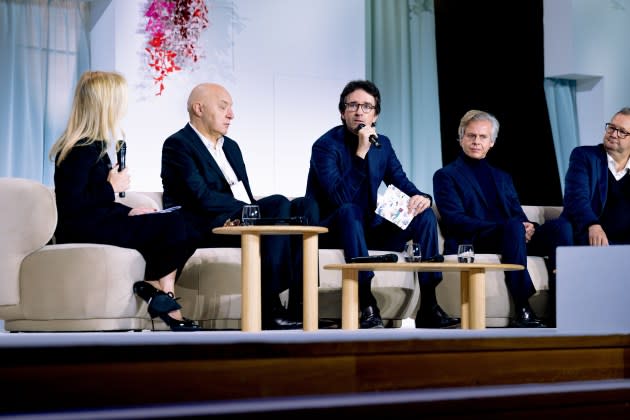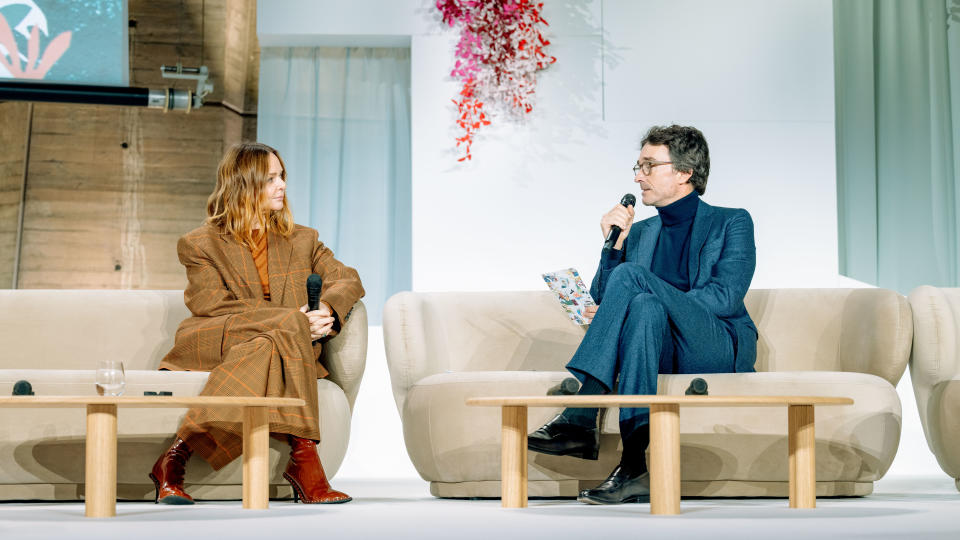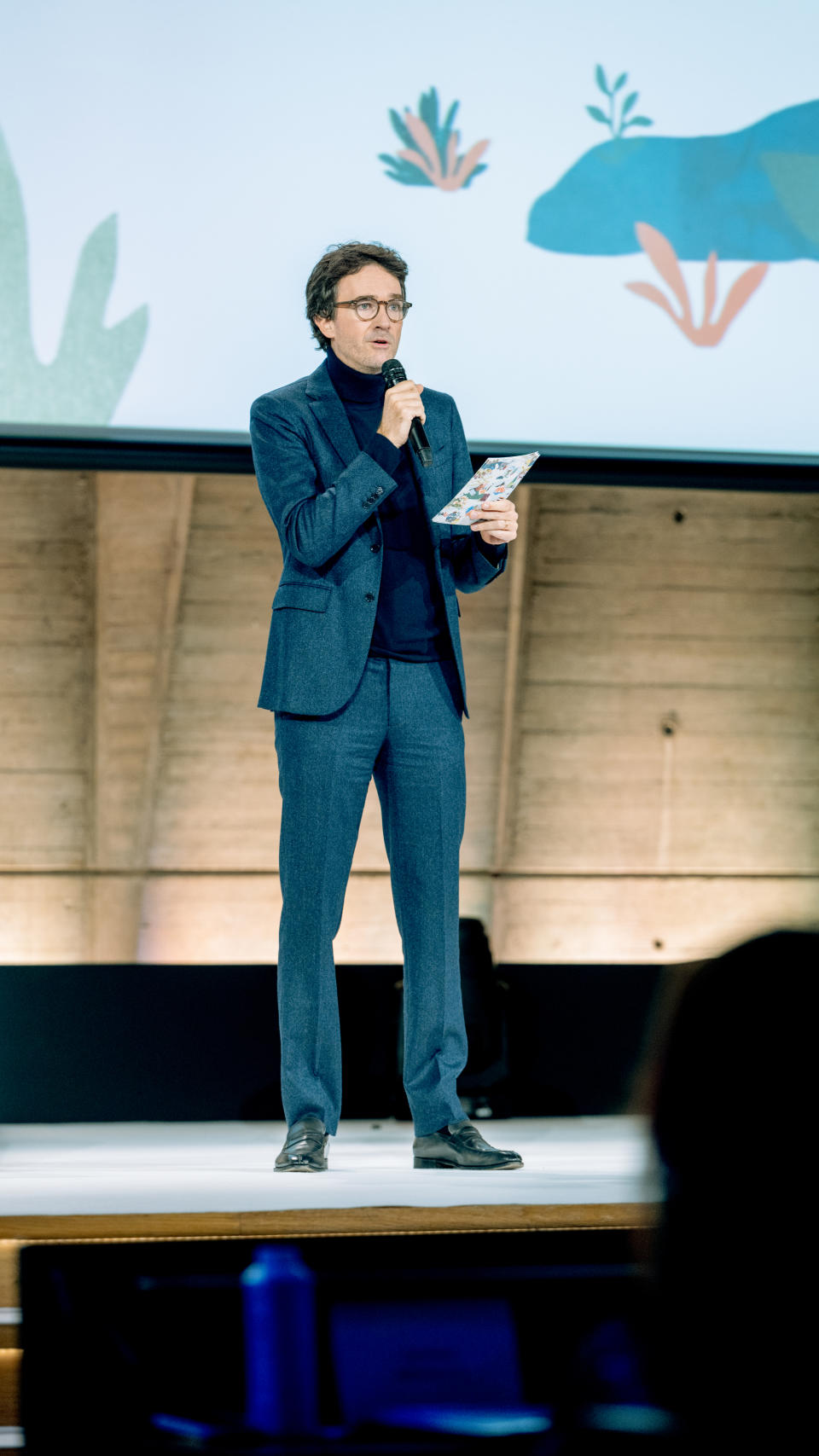LVMH, Chanel to Harmonize CSR Reporting at Supplier Level

PARIS — The luxury world is recognizing that when it comes to sustainability, cooperation is better than competition.
In a groundbreaking tie-up of two of the world’s largest luxury groups, LVMH Mo?t Hennessy Louis Vuitton on Thursday revealed it will cooperate with Chanel to harmonize corporate and social responsibility reporting and audit schedules at the supplier level. It will also directly support its suppliers through a partnership program titled Life 360 Business Partners, and will launch LVMH Circularity, which will reuse unsold products from across group houses in new projects, among other initiatives.
More from WWD
The initiatives were revealed as LVMH held a full-circle day of sustainability under its Life 360 banner, bringing together brand presidents and creative directors at the UNESCO headquarters in Paris, hosted by the group’s head of image and environment, Antoine Arnault.
LVMH chief Bernard Arnault also acknowledged LVMH and Chanel working together. “The environmental challenge redefines the usual rules of competition,” the chairman and chief executive officer said. Arnault said that competition should be on design and creativity, and businesses can share information.
“I believe it is our duty to know how to rise above the usual patterns. This is why we have chosen to invite certain competitors today,” he added. “Progress of any kind is crucial. We must join forces.”
During the day, the French luxury group discussed its wins, such as meeting its 10 percent energy reduction target at its stores, and where it is facing challenges such as removing fossil fuel-based plastic from its packaging.
The partnership program with suppliers will include financial support and coinvestment, as well as education and other initiatives to bring the suppliers on board as partners, hopefully making any mandatory changes positive rather than penalizing.
“The name of the game from now on for us is going to be Scope 3,” Arnault told WWD, about extending its sustainability reach further afield. Scope 3 is the supplier level.
“It’s the part of our mission that we control the least by definition; however, we are going to try to help our suppliers and our partners be more active on this topic — to train them, and to invest with them in their transition,” he said. Antoine Arnault acknowledged that companies at this level often face big financial challenges to overhaul their businesses.
“However, we cannot compromise,” he added.
Compliance mechanisms will be stringent but supported with training. “It’s quite tough, but we hope they see it as something helpful and that will help them in their transition,” he added, using the example of vintners trying to transition away from pesticides and herbicides but grappling with lower yields at harvest. “We are going to help them transition also financially and find ways to be more helpful toward our common suppliers,” he said.
Competitors to Cooperate
To that end, LVMH will be cooperating with Chanel at the supplier level.
Antoine Arnault said the two groups have the same vision of luxury and “strongly believe that we will need to work together to move faster.”
Mindful of regulatory and antitrust constraints, the groups will coordinate as much as possible on things like sourcing and vetting of suppliers. While the agreement is in its early days, they have several ideas on the table. Audits are one example Arnault shared. The groups hope to create a collective audit system so that suppliers do not have to repeat their work multiple times.
“We basically just started addressing it, but I know that it is really going to be helpful to have partners we work with.”
Chanel SAS president Bruno Pavlovsky spoke on video about building the alliance between the groups that often source from the same suppliers.
“These are collective challenges as all luxury brands are supplied with leather, cotton, silk and cashmere. Only defined alliances will allow us to help the upstream transform,” he said. Businesses and brands will continue to work within their own creative ecosystems.
“There is also an economic challenge. Right now, cotton from regenerative agriculture which meets all the correct criteria will cost more than bottom-of-the-range cotton, so collectively we need to accept that that is the case. I believe that it is clearly by creating alliances and working together on a defined subject that we will be able to make progress,” he added.
Onstage, Chanel supply chain and ecological transition director Eric Dupont said the privately held luxury house came to the decision to work together with LVMH due to the urgency of the climate crisis. “The stakes are higher than one brand or group,” he said. The alliance will see the groups work together on best practices, particularly on leather, and how to define standards for the suppliers.
At the end of the day, LVMH chief Bernard Arnault took to the stage to reiterate the company’s conviction that climate can be a business decision.
“Action for climate and biodiversity will only be effective if it is seen as a real industrial strategy. The reduction in greenhouse gas emissions cannot be improvised. The protection of biodiversity cannot be improvised. The shift in the agricultural model means that regenerative agriculture cannot be improvised. All these objectives can only be achieved through thoughtful, documented strategies,” he said.
Bernard Arnault also acknowledged LVMH and Chanel working together. “The environmental challenge redefines the usual rules of competition,” he said. Arnault said that competition should be on design and creativity, and businesses can share information.
“I believe it is our duty to know how to rise above the usual patterns. This is why we have chosen to invite certain competitors today,” he added. “Progress of any kind is crucial. We must join forces.”
Much of the day was focused on how luxury players can work together, even from sectors as diverse as spirits to fashion.
The French Fédération de la Haute Couture et de la Mode executive president Pascal Morand said the organization has been working intensively behind the scenes to foster collaboration between the houses.
“The main problem of the fashion industry itself is a volumetric problem,” he said, highlighting that the garment industry turns out about 130 billion pieces a year. Morand has also been working with the European Parliament on crafting some rules that will regulate the fashion industry, including the Eco-design for Sustainable Products Regulation.
Morand said the current proposals are focused on durability and functionality and ignore other factors, including fabric composition, as well as brand value. As a result, there is a paradox in the industry where sometimes luxury products are poorly rated on that scale, or vice versa, he said. “It’s not a case of bad intentions, but it’s a complex system,” of the hard metrics that are proposed.
Changing this system for the long term requires a combination of global governance and legislative solutions, alongside the private sector. At this stage, cooperation is needed to get accurate data and granularity needed to transform the industry.
“This is why we do work with each other…in search of rigor,” he said.

If the day was a music festival, the rock star was of course a McCartney, with Stella taking the stage in conversation with Arnault. The designer and animal advocate started her line in 2001.
“I’m the grandma of sustainability here,” she joked of her 20-year-plus advocacy of sustainability. McCartney has never used animal products in her designs, even when she was an outlier in the industry.
Things have changed. “The next generation of people we’re all going to employ, they will want to work in businesses like this,” she said.
“The biggest impact we have in a positive way on the environment is not using animal products. Agriculture is massively damaging to the planet,” she said, adding that working with animals as products can also be damaging to the people that handle the labor. “It can be very harmful to human welfare. I think that should be in the conversation also.”
McCartney discussed her work with LVMH’s Veuve Clicquot to create grape leather and cork soles for shoes, as well as her championing of Mirim, a plastic-free mushroom-based leather, which is poised to scale up.
“Scalability is the only real answer, because everyone in here — we have businesses to run, right? It’s the only way to swap out bad business. Innovation is really exciting,” she said.
McCartney had also been present at COP28 in Dubai. “You can lose a little bit of hope in that room; here I have a little more hope,” she said about bringing the various stakeholders together at the daylong conference. She encouraged the LVMH employees to be innovative to tackle issues from new positions. “You have to cooperate to solve this problem. Every day at work you need to think outside of the box.”
Creative Directors Taking Steps
One example was creating new hangers, said Patou artistic director Guillaume Henry.
He took to the stage with Dior Men’s and Fendi women’s creative director Kim Jones and Dior perfume creation director Francis Kurkdjian to discuss the various efforts at each of their houses.
Henry said when he realized that getting a garment from factory to store took three hangers, the brand reduced it to one with a new design. He also noted that the brand’s core line of white shirts and black blazers, called Essentiels, is still its bestseller.
Jones discussed Dior Men’s collaboration with Parley for the Oceans that has resulted in two collections that are made from recovered ocean plastic as another example. Its denim capsule collection released in September is made with 100 percent regenerative cotton.
He’s taking on other collections and incorporating alternative materials as much as possible. “With 22 collections a year it is a challenge, but we are getting to the point where we can do that,” he said.
Kurkdjian said one of the biggest challenges for the industry is going to be changing consumers’ perceptions that quantity, heft and volume equals luxury. Kurkdjian noted the industry has spent decades telling the customer one thing, and now has to work to change that perception.
“Nowadays the challenge is to help the client discover that light and sustainable is precious, more than just big and gigantic. It’s a mindset,” he said.
Many of the brand executives acknowledged that transportation is one of their biggest carbon challenges, and they are working to find solutions including more shipping by ocean or rail instead of air freight or trucks.
Packaging is another challenge, both at the brand and the group level, with eliminating plastic a major roadblock. The group will also examine its advertising and media practices, including how photo shoots are conducted.

Speaking from the stage, Arnault was direct: “Things are not getting better, and businesses cannot continue to thrive in a world overheating,” he said.
Arnault added the group is willing to acknowledge that while it is making progress on its goals, there is still a long way to go. “But what I can tell you is that everybody inside LVMH is mobilized that we are conscious that we have a huge responsibility as the leader of the sector, and that we’re taking this into our hands,” he said. “Let’s also be at the same time realistic and honest, our goal is still to continue to grow. And we will continue within that constraint in a way to produce in the best possible way.”
Best of WWD
Solve the daily Crossword

